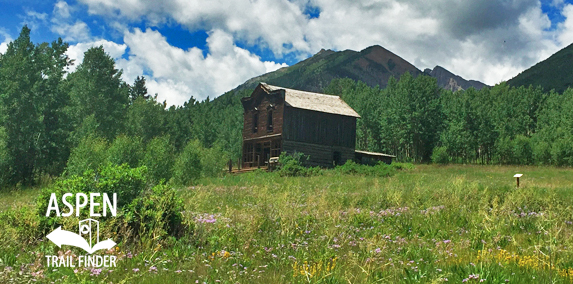Connects: Castle Creek Road (CR 15), Express Creek Road (FSR #122), River Run Trail, Ashcroft Ski Touring Trails (Winter)
![]()
![]()

The old hotel at the Ashcroft Ghost Town
Aspen, CO – Ghost Town
The Ashcroft Ghost Town is a site 11 miles up Castle Creek Road near Aspen, CO. Admission is $3. Dogs are not allowed in the ghost town. Ashcroft, Colorado is listed on the National Register of Historic Places.
News about the Town of Ashcroft can be found at:
Aspen Journalism (December 17, 2017) – Big mountain ski dream: Ski-Hayden was a pre-war vision of what could have been
More information about the Ashcroft Ghost Town can be found at:
National Park Service – National Register of Historic Places – Ashcroft Colorado
Aspen Historical Society – Ashcroft Ghost Town
Wikipedia – Ashcroft, Colorado
At an elevation of 9,500 feet, the Castle Creek Valley served as a summer foraging and hunting camp for native nomadic travelers for hundreds of years. The Tabeguache band of the White River Ute Indians, now called the Ucompahgre Band, historically and archaeologically are known to have travelled through the surrounding valleys that drain into Castle Creek, the Roaring Fork and the Colorado Rivers. The Ute Indians refer to themselves as Nuche, simply meaning “the people”. While much of the Ute oral history is lost with time, it is believed that Chief Colorow may have led his band to the Castle Creek valley annually in the mid-1800s.
By the late 1800s the minimal needs and impact of the Ute Indians were swallowed up by the insatiable wants of the United State’s belief in “manifest destiny”. Mining towns boomed and busted according to the whims of geology, economic markets, and, in the case of silver, the U.S. government. Ashcroft, a silver mining town founded in 1800, gambled against these forces and lost.
At the height of Ashcroft’s boom, over 2000 people lived here. High transportation costs, shallow silver deposits, competition from Aspen, and ultimately the 1893 silver market crash destroyed the viability of the town.
Ashcroft’s population plummeted to 100 by 1895. In 1912, when the U.S. Postal Service suspended mail delivery to Ashcroft, the town claimed only 50 residents. Ashcroft, although a ghost town, is not dead. Today, more people visit Ashcroft each summer than ever lived here.
Your donations matter! The Ghost Town of Ashcroft is a Nationally Registered Historic Site maintained as an educational resource by the Aspen Historical Society, a 501c3 nonprofit, in partnership with the White River National Forest Service. All funds are used on site to help ongoing preservation of trails, picnic areas, signage, facilities, and to provide the Ghost Interpreters. Thank you for your support.”
The first settlement was made on the present townsite by a few men in June, 1880. By the end of 1880, a considerable number of people had settled here. Inspiteofthelocal Indian presence, the men dug in where the two forks of Castle Creek met, and called their location “Castle Forks”. In 1880, the townsite was laid out on this spot on a placer claim known as “Chloride.”
In 1881, a post office was acquired, and called Chloride. On January 3, 1882, the town’s name was changed to Ashcroft, (after Thomas E. Ashcroft, one of the original party of prospectors).
In 1881, the town had a population of 500. The town boom really started in 1882, and daily mail and stage service to Aspen, Independence and Leadville was instituted.
By 1883, the town population had grown to 2,000 people. The peak population was 2,500.
The rich silver strikes in Aspen drew many of the local populace away from Ashcroft. Local transportation problems, together with a shortage of funds for the development of the mines, had a telling effect on the stability of the Ashcroft growth and prosperity.
The arrival of the railroads in Aspen had a telling ef- fect on Ashcroft, as it was no longer necessary to transport ore by mule over Taylor and Pearl Passes through Ashcroft.
By 1890, the town had declined rapidly and most the business firms had closed.
The post office was closed November 30, 1912.
The nine buildings remaining in Ashcroft are in a very deteriorated condition, having remained here since 1879 with very little maintenance.
From the 1930’s, Ashcroft has been recognized as a true Colorado ghost town.
Only a few of the prospectors remaining in Ashcroft to enjoy “The paradise of the Elk Mountains” until their deaths in the 1950’s.
Its primary significance is that it is one of the few remaining “True Colorado ghost towns”.”

























